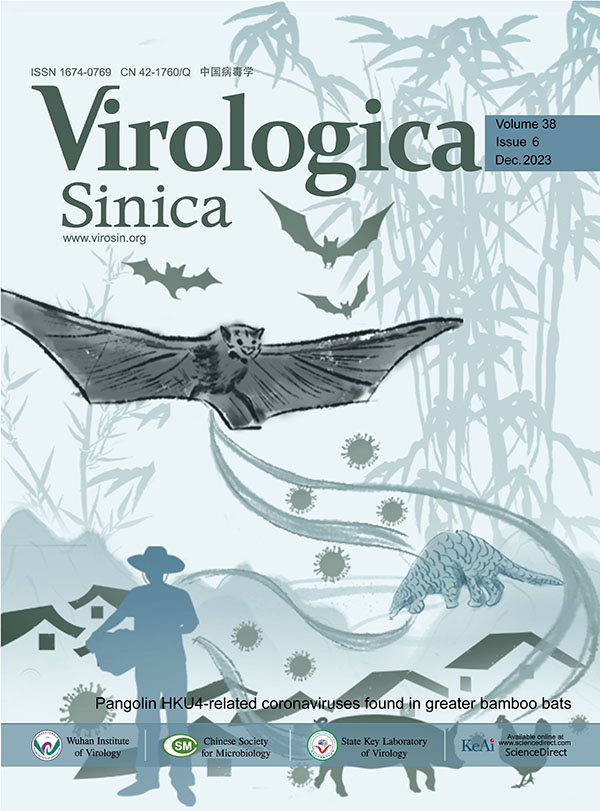-
Baseler L, Chertow DS, Johnson KM, Feldmann H, Morens DM (2017) The Pathogenesis of Ebola Virus Disease. Annual review of pathology 12: 387-418.
-
Batra J, Hultquist JF, Liu D, Shtanko O, Von Dollen J, Satkamp L, Jang GM, Luthra P, Schwarz TM, Small GI, Arnett E, Anantpadma M, Reyes A, Leung DW, Kaake R, Haas P, Schmidt CB, Schlesinger LS, LaCount DJ, Davey RA, Amarasinghe GK, Basler CF, Krogan NJ (2018) Protein Interaction Mapping Identifies RBBP6 as a Negative Regulator of Ebola Virus Replication. Cell 175: 1917-1930 e1913.
-
Cao Z, Xia H, Rajsbaum R, Xia X, Wang H, Shi PY (2021) Ubiquitination of SARS-CoV-2 ORF7a promotes antagonism of interferon response. Cellular & molecular immunology 18: 746-748.
-
Cardenas WB, Loo YM, Gale M, Jr., Hartman AL, Kimberlin CR, Martinez-Sobrido L, Saphire EO, Basler CF (2006) Ebola virus VP35 protein binds double-stranded RNA and inhibits alpha/beta interferon production induced by RIG-I signaling. Journal of virology 80: 5168-5178.
-
Feldmann H, Jones S, Klenk HD, Schnittler HJ (2003) Ebola virus: from discovery to vaccine. Nature reviews Immunology 3: 677-685.
-
Hoenen T, Groseth A, Kolesnikova L, Theriault S, Ebihara H, Hartlieb B, Bamberg S, Feldmann H, Stroher U, Becker S (2006) Infection of naive target cells with virus-like particles: implications for the function of ebola virus VP24. Journal of virology 80: 7260-7264.
-
Huang Y, Xu L, Sun Y, Nabel GJ (2002) The assembly of Ebola virus nucleocapsid requires virion-associated proteins 35 and 24 and posttranslational modification of nucleoprotein. Molecular cell 10: 307-316.
-
Jacob ST, Crozier I, Fischer WA, 2nd, Hewlett A, Kraft CS, Vega MA, Soka MJ, Wahl V, Griffiths A, Bollinger L, Kuhn JH (2020) Ebola virus disease. Nature reviews Disease primers 6: 13.
-
Koyama S, Ishii KJ, Coban C, Akira S (2008) Innate immune response to viral infection. Cytokine 43: 336-341.
-
L.J.Reed HM (1938) A Simple Method of Estimating Fifty per cent Endpoints. The american journal of Hygiene 27: 493-497.
-
Leung DW, Ginder ND, Fulton DB, Nix J, Basler CF, Honzatko RB, Amarasinghe GK (2009) Structure of the Ebola VP35 interferon inhibitory domain. Proceedings of the National Academy of Sciences of the United States of America 106: 411-416.
-
Martines RB, Ng DL, Greer PW, Rollin PE, Zaki SR (2015) Tissue and cellular tropism, pathology and pathogenesis of Ebola and Marburg viruses. The Journal of pathology 235: 153-174.
-
Mateo M, Reid SP, Leung LW, Basler CF, Volchkov VE (2010) Ebolavirus VP24 binding to karyopherins is required for inhibition of interferon signaling. Journal of virology 84: 1169-1175.
-
Mehedi M, Falzarano D, Seebach J, Hu X, Carpenter MS, Schnittler HJ, Feldmann H (2011) A new Ebola virus nonstructural glycoprotein expressed through RNA editing. Journal of virology 85: 5406-5414.
-
Meylan E, Tschopp J, Karin M (2006) Intracellular pattern recognition receptors in the host response. Nature 442: 39-44.
-
Novick D, Cohen B, Rubinstein M (1994) The human interferon alpha/beta receptor: characterization and molecular cloning. Cell 77: 391-400.
-
Panchal RG, Ruthel G, Kenny TA, Kallstrom GH, Lane D, Badie SS, Li L, Bavari S, Aman MJ (2003) In vivo oligomerization and raft localization of Ebola virus protein VP40 during vesicular budding. Proceedings of the National Academy of Sciences of the United States of America 100: 15936-15941.
-
Prins KC, Cardenas WB, Basler CF (2009) Ebola virus protein VP35 impairs the function of interferon regulatory factor-activating kinases IKKepsilon and TBK-1. Journal of virology 83: 3069-3077.
-
Ramanan P, Shabman RS, Brown CS, Amarasinghe GK, Basler CF, Leung DW (2011) Filoviral immune evasion mechanisms. Viruses 3: 1634-1649.
-
Rasmussen AL (2018) Host Factors Involved in Ebola Virus Replication. Current topics in microbiology and immunology 419: 113-150.
-
Rougeron V, Feldmann H, Grard G, Becker S, Leroy EM (2015) Ebola and Marburg haemorrhagic fever. Journal of clinical virology : the official publication of the Pan American Society for Clinical Virology 64: 111-119.
-
Sanchez A, Trappier SG, Mahy BW, Peters CJ, Nichol ST (1996) The virion glycoproteins of Ebola viruses are encoded in two reading frames and are expressed through transcriptional editing. Proceedings of the National Academy of Sciences of the United States of America 93: 3602-3607.
-
Schoggins JW (2014) Interferon-stimulated genes: roles in viral pathogenesis. Current opinion in virology 6: 40-46.
-
Shen Q, Wang YE, Palazzo AF (2021) Crosstalk between nucleocytoplasmic trafficking and the innate immune response to viral infection. The Journal of biological chemistry 297: 100856.
-
Smith LM, Hensley LE, Geisbert TW, Johnson J, Stossel A, Honko A, Yen JY, Geisbert J, Paragas J, Fritz E, Olinger G, Young HA, Rubins KH, Karp CL (2013) Interferon-beta therapy prolongs survival in rhesus macaque models of Ebola and Marburg hemorrhagic fever. The Journal of infectious diseases 208: 310-318.
-
Stark GR, Darnell JE, Jr. (2012) The JAK-STAT pathway at twenty. Immunity 36: 503-514.
-
Takada A, Robison C, Goto H, Sanchez A, Murti KG, Whitt MA, Kawaoka Y (1997) A system for functional analysis of Ebola virus glycoprotein. Proceedings of the National Academy of Sciences of the United States of America 94: 14764-14769.
-
Tao W, Gan T, Guo M, Xu Y, Zhong J (2017) Novel Stable Ebola Virus Minigenome Replicon Reveals Remarkable Stability of the Viral Genome. Journal of virology 91: e01316-17.
-
Valmas C, Grosch MN, Schumann M, Olejnik J, Martinez O, Best SM, Krahling V, Basler CF, Muhlberger E (2010) Marburg virus evades interferon responses by a mechanism distinct from ebola virus. PLoS pathogens 6: e1000721.
-
Wang R, Zhang H, Peng C, Shi J, Zhang H, Gong R (2021) Identification and Characterization of a Novel Single Domain Antibody Against Ebola Virus. Virologica Sinica 36: 1600-1610.
-
Wynne JW, Todd S, Boyd V, Tachedjian M, Klein R, Shiell B, Dearnley M, McAuley AJ, Woon AP, Purcell AW, Marsh GA, Baker ML (2017) Comparative Transcriptomics Highlights the Role of the Activator Protein 1 Transcription Factor in the Host Response to Ebolavirus. Journal of virology 91: e01174-17.















 DownLoad:
DownLoad: